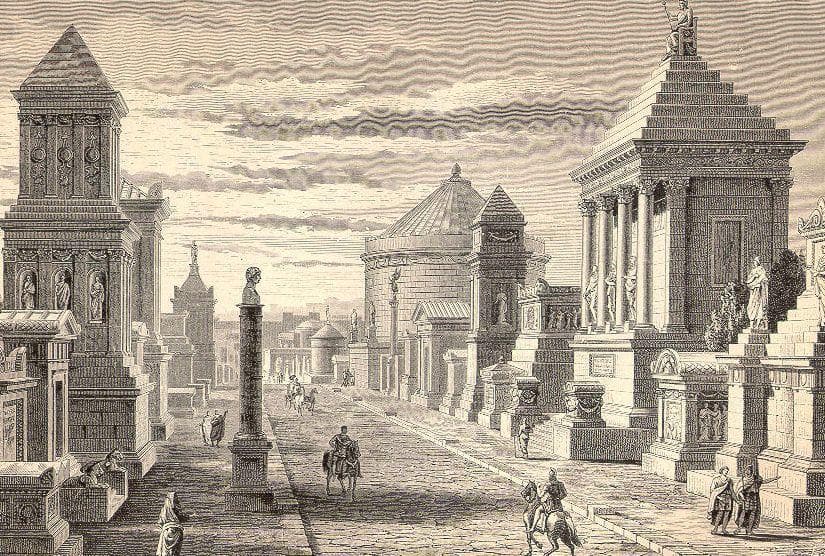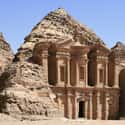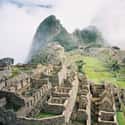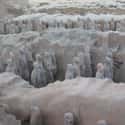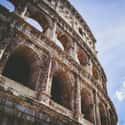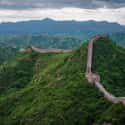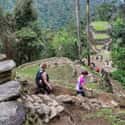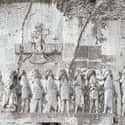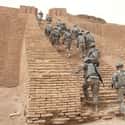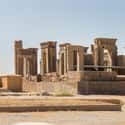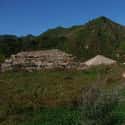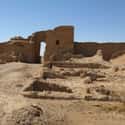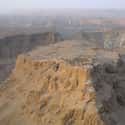(#1) Petra
- Jordan
This stunning city served as a crossroads between many different trade routes in the late 1st century BCE, but what makes this city truly unforgettable is its amazing architecture. Many of its tombs and other buildings are made with intricate stonework. While some buildings are free standing, many are carved out of the side of mountains and rockfaces. It also has a complex hydraulic engineering system throughout the city. The people that lived here during its early years were known for their skilled craftsmanship of textiles, metals, and pottery.
In modern times, the city is most recognized from the film Indiana Jones and the Last Crusade. The city still has gorgeous temples, including Al-Khazneh, or "the Treasury." Builders of this ancient city combined diverse cultural influences from the many travelers residing there or passing through. Because of this, Petra features a diversity of buildings, ranging from theaters to dining rooms, cut from the living rock.
(#2) Machu Picchu
- Cusco Region, Peru
This stunning complex located in the mountains of Peru is comprised of 200 religious and ceremonial structures. Perhaps once a sacred retreat for Incan royals, Machu Picchu boasted incredible masonry techniques - its granite blocks were fitted together without mortar - and even a sacred sundial. The city was eventually abandoned after the Spanish brutally slaughtered the Inca, but it was uncovered again in 1911 by American historian Hiram Bingham. In 1981, Peru declared the site as a historical sanctuary, and two years later the United Nationals Educational, Scientific, and Cultural Organization named the site as a World Heritage Site.
(#3) Angkor Wat
- Cambodia
Angkor Wat was the former epicenter of the Khmer kingdom in what is now known as Cambodia. This massive temple complex is the largest religious monument in the world. The temple complex and the surrounding city began construction in the 9th century (not technically 'the Ancient World,' fine) and its main temple was erected in the 12th century. Khmer King Suryavarman II transformed the temple from a monument to the Hindu god Vishnu to a Buddhist temple toward the end of the 12th century.
The complete complex is absolutely massive. It is about 402 acres, equipped with a 213-foot-tall tower and surrounded by a giant moat. The nearby city was also quite large at its height - nearly a million people lived there.
(#4) Terracotta Army
- Xi'an, China
Qin Shih Huang Di, the first official emperor of a united China, was an extraordinary, yet brutal, ruler. Born Ying Zheng, Emperor Qin took to the throne at age 13 in 246 BCE. He believed in military power, and rapidly expanded China's borders with force. He is also credited for building the first part of what is now known as the Great Wall of China.
Through his life, Qin was on a quest for immortality and was obsessed with death. Almost immediately after ascending to the throne, he commissioned his tomb to be built in modern-day Xi'an. He employed 700,000 workers to build a personal army of 6,000 terracotta statues of soldiers and horses, each one with individualized features and insignia of rank. Uncovered in the 1970s, this "terracotta army" would accompany the king in life just as they did in life.
(#5) Colosseum
- Rome, Italy
Now known as the Colosseum, this giant amphitheater in Rome began construction under the reign of Emperor Vespasian in the 70s CE. His son Titus finished it up a few years later, celebrating with 100 days of games and fights. The huge arena inside was covered in sand, perhaps dyed red to conceal blood, and played host to gladiatorial combats, sea battles (they flooded the arena for these), and wild animal fights. Also called the Flavian Amphitheater - named for Vespasian and Titus, whose family name was Flavius - it could seat between 50,000 to 80,000 spectators.
(#6) Great Wall of China
- Shanhaiguan District, China
Emperor Qin Shih Huang Di - the first emperor of a united China who built himself a terracotta army for eternity - also commissioned the Great Wall of China. While his vision wasn't the wall we all know today, it was the framework for it. Successive emperors of later dynasties constructed the other major portions of it.
Some of the original construction actually dated before the Qin emperor, and were regular military garrisons. Qin ordered various northern walls all be linked up to create one mega-wall to protect his empire against "barbarians" and feudal lords. Overtime, the wall grew to be 12,500 miles long, much of which still stands today.
(#7) Ciudad Perdida
- Colombia
Ciudad Perdida - located in Colombia - literally translates from Spanish to "the Lost City." It was built 300 years after Machu Piccu - another ancient Latin America site - and spread out over 75 acres. It has 200 buildings that can be accessed by a 1,200 step staircase. But it probably wasn't a ceremonial center like Machu Picchu. It most likely served as a residential city where only a few thousand people lived. It remained occupied until the Spanish conquistadors invaded and massacred the inhabitants about 400 years after it was built.
It was rediscovered in 1972 by a group of treasure looters who found the stone staircase. Inside the city, they found gold figurines and ceramic urns, which they sold on the black market. Archeologist discovered the artifacts, and four years later made their way to the lost city. Local native tribes said they always knew of the city's existence but kept quiet about it.
(#8) Behistun Inscription, Which Helped Archaeologists Decipher Cuneiform
The Behistun Inscription is a fascinating piece of writing inscribed on a 300-foot-tall rock in Iran. It's located on what used to be the Aryan Trade Roads - also known as the Silk Roads. This seemingly random rock relief actually served a very important purpose in the history of archeology. Written on the rock is a text using Old Persian, Akkadian, and Elamite that was commissioned by Darius the Great. In it, Darius described his rise to power.
Similar to the Rosetta Stone, the tri-lingual Behistun Inscription provided archeologist Henry Rawlinson with the opportunity to decipher Old Persian and Akkadian cuneiform in 1835. He worked for years copying down the inscription and comparing it to Persian. Together with other scholars, they translated the passages from Elamite and Akkadian. Thanks to this inscription, later generations of scholars were able to read thousands of very important texts.
(#9) Ziggurat of Ur
- Iraq
The Ziggurat is a stepped pyramid constructed with a series of mud and brick platforms in ancient Mesopotamia. At the end of the 3rd millennium BCE., King Ur-Nammu of Ur, a Mesopotamian city-state, began to build monumental temple-towers in the form of ziggurats. Surrounded by a double wall and containing a sacred space dedicated to the god Nanna, the moon god on the top, the entire complex once occupied 124 acres. Basically, the higher up you went, the more sacred and exclusive the space.
(#10) Pyramids of Meroe
Located in modern Sudan, these pyramids are relics of the Kushite civilization of ancient Nubia. They're different than their northern counterparts - steeper and a bit smaller - and there are about 200 of them all together. While their pyramids are different from the Egyptian pyramids, the residents of ancient Nubia interacted with the Egyptians to their north, creating a cultural and ideological exchange.
These were built between 2,300 and 2,700 years ago. Their design elements include cultural influences from Egypt, Greece, and Rome. Tourism used to boom in this region, but in the past 30 or so years has slowed down substantial. This is partly due to civil war in the country and the conflict in Darfur.
(#11) Great Living Chola Temples
The Great Living Chola Temples are three southern Indian temples built in the 11th and 12th centuries CE. These divine palaces were often dedicated to the god Shiva and patronized by the wealthiest classes, serving as centers of religious and political unity for a great empire. Constructing the temples offered up tons of employment possibilities and lots of economic advancement for artisans. And the temples themselves were works of art, with ornate stonework and construction.
The Brihadisvara Temple, which stands at 216 feet in the air, attracts tons of tourists. It's the biggest of the three temples and considered the most popular.
(#12) Persepolis
- Iran
Persepolis was once the capital of the great Achaemenid Empire. The ancient city - located in modern-day Iran - was built around 500 BCE under the instruction of King Darius I.
The "Gate of All Nations," aka the "Xerxes Gate," was the ceremonial entryway to the city of Persepolis. Complete with giant winged creatures called lamassu (bulls mixed with men and birds), the self-referential "gate" led to stairs that featured a depiction of subjects coming from all over the empire to visit the King. Once visitors walked up these stairs, they would head into the audience hall, or the apadana. There, they would be wowed by 72 giant columns and the presence of the King, who would receive a really nice gifts.
(#13) Hadrian's Wall
- United Kingdom
Named after the man who ordered its construction, Hadrian's Wall marked off the northwestern end of the Roman Empire for a long time. Extending 73 miles and measuring eight feet wide, the wall is peppered with little forts to house soldiers. Its purpose? To separate the "barbarians" from the Romans.
Emperor Hadrian - the leader of the Holy Roman Empire - commissioned the wall in 122 CE. It crossed Britain from the town of Wallsend on the River Tyne to the North Sea at Solway Firth. Along the wall's path are turrets and Roman forts meant to act as patrol bases. At the time of its conception, Hadrian was experiencing pushback from Brits to the north. Fearing rebellion, he build a wall to keep a possible uprising out. It's common misconception the wall is the border between England and Scotland. While the Scottish border is actually less than a mile from the wall, they have nothing to do with one another.
(#14) Capital Cities and Tombs of the Ancient Koguryo Kingdom
The Koguryo dynasty was an important kingdom in ancient Korea that spanned from the 1st century BCE to the 7th century CE. One of its more lasting impacts, though, were the stunning tomb murals they left behind that emphasized movement and a fierce warrior spirit. Located in stone tomb chambers, these funerary monuments also had constellation charts - demonstrating the Koguryo kingdom's knowledge of astronomy - and depictions of daily royal life. You can even see an example of a sword dance on these tomb murals.
These murals are one of the few things that have survived in Korea from this time period. So far, 70 murals have been discovered, but archeologists continue digging for more.
(#15) Dura-Europos
- Syria
This Syrian town - successively controlled by the Macedonians, Parthians, and Romans - was a true cultural melting pot between the West and the East. The people there were a mixture of Greeks, Palymreneans, and Arameans who all had strong senses of culture. These populations produced a uniquely hybridized society. Home to lots of temples, Dura-Europos had one of the world's earliest synagogues, a Mithraeum (an underground temple to the soldier/bull god Mithras,) and a church, all built under Roman rule.
It's often called the "Pompeii of the desert" because of its exquisite ruins hidden underground. The ruins of Dura Europos contain paintings and bas-reliefs from the synagogue and the Mithraeum that are truly works of art. Sadly, like many other Syrian sites, it has been damaged by ISIS.
(#16) Masada
- Israel
When the ancient Romans came to conquer Judea, they found a very resistant population. In the 1st century CE, they slowly took each part of what is now Israel, forcing the remaining resisters to a defensible desert mountaintop called Masada. Once the site of a Herodian fortress, Masada became a rebel garrison. It was the last bastion of Judean hope against the Romans, who eventually forced their way into Masada.
Before the Romans could capture the rebels, though, the remaining Judean forces killed themselves rather than be taken into slavery by their enemies. Or so the Romano-Jewish historian Flavius Josephus tells us. But modern scholars cast doubt on the patriotic intent of the near-thousand who killed themselves; some suggest that the heroic mass suicide at Masada was a myth.
New Random Displays Display All By Ranking
About This Tool
Human civilization has a long history. There are as many historical monuments as stars on the earth that record the history and culture of mankind and are the crystallization of human wisdom. There are countless monuments in the world, and some have a history of hundreds or even thousands of years. Although some underrated sites only have bricks now, they are still fascinating.
With the advancement of technology, archaeologists can use technology to restore the original appearances of these underrated historical monuments, allowing more people to see the wonders of the ancient world. Here the random tool collected 16 amazing monuments around the world.
Our data comes from Ranker, If you want to participate in the ranking of items displayed on this page, please click here.

